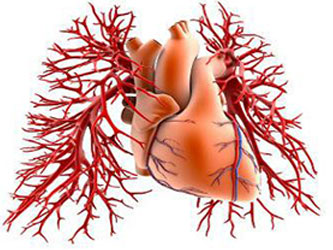The Vascular System
The vascular system or the circulatory system in the human body comprises of a network of flexible tubes or blood vessels, which include the arteries, veins, the capillaries, and Lymph vessels and nodes. The arteries carry blood away from the heart, while the veins carry blood to the heart. The lymph vessels and nodes are part of the cleaning system that clears the waste products from our body and help prevent such diseases as cancer. The term vascular comes from a Latin word that means “hollow containers”. The disorders that affect the arteries, the veins and the lymph system are known as vascular disease.
Types of Vascular Diseases
- Aneurysms
- Atherosclerosis and Peripheral Artery Diseases (PAD)
- Blood Clotting Disorders
- Blood Clots in Veins (VTE)
- Buerger’s Disease
- Lymphedema
- Peripheral Venous Disease
- Raynaud’s Disease or Syndrome
Causes and Symptoms
Aneurysms – a bulge in any of the walls of the blood vessels is called an aneurysm. Most commonly occurring area for an aneurysm is the aorta (aortic aneurysm) or in the abdomen. Small aneurysms create risks for other disorders to occur. Aneurysms could grow larger and press on the nearby organs causing pain, or since the wall is stretched thin due to the bulge, it could burst, which could lead to dire consequences.

Atherosclerosis and Peripheral Artery Disease (PAD) – Arteries that supply blood to the muscles of the heart are known as Coronary Arteries. The peripheral arteries that carry blood to the tissues and organs (other than the heart) in the human body, over a period of time develop plaque on the inner walls of the arteries. Deposits of fat, cholesterol and other substances are known as plaque. As the plaque builds up the passage for the blood to flow through becomes narrower. This results in less blood supply to the tissues or organs. The symptoms and disorders due to PAD are varied and different. Some examples:
1. Any blockage in the coronary arteries causes chest pain or a heart attack.
2. Any blockage in the arteries (carotid arteries) that supply the brain with blood, can result in a stroke or transient ischemic attack.
3. Any blockage to the kidneys could lead to high blood pressure, heart failure and dysfunctional kidneys.
4. Claudication refers to a blockage in the legs and this can lead to pain in the legs when active, change in skin colour, development of sores or ulcers and a feeling of tiredness in the legs.
When sufficient blood flow is not there to the tissues or organs then the tissues or organs will die.
Blood Clotting Disorders – Sometimes some illnesses may cause blood clots or it could be a birth disorder. The possible disorders include:
- Higher than normal levels of prothrombin, fibrinogen and factor 8, which help form blood clots
- Insufficient anticoagulants (blood thinning proteins), antithrombin, protein C and S
- Issues in breaking down of fibrin
- Damage to the endothelium (the lining of the blood vessel)
Blood Clots in Veins (VTE) – When a blood clot in the vein, which is in the muscle occurs it mostly occurs in the lower extremities, pelvic or thigh region. If this clot travels to the lungs it becomes a pulmonary embolism and clots in the veins are called venous thromboembolisms (VTE). Causes include:
- Any condition that causes the blood to flow slowly or thickens the blood such as congestive heart failure and tumors of a certain type
- Genetic disorders that cause blood to clot
- Valves in the veins that are damaged
- Veins that are damaged due to infection or injury
- Hormones such as estrogen due to a pregnancy or birth control pills
- Long-term bed rest and inability to move
- Surgery – such as procedures on the hips and legs
DVT or damaged vein valves can cause long-term pooling of blood and swelling in the legs. This is called chronic venous insufficiency. If no action is taken then the fluid will filter into the tissues in the ankles and feet, eventually wearing the skin away.
Buerger’s Disease – A very rare disease that affects the small and medium-sized arteries and veins that are in the arms and legs. Blood supply is cut off to the fingers, toes, hands and feet, causing swelling and constant pain. Though the direct causes are unknown, this disease is associated with the use of tobacco, chewing tobacco, cigars and secondary smoke. People with this disease may also have Raynaud’s disease.
Lymphedema – Unlike the circulatory system the lymph vessels do not have pumps to circulate the lymph. The lymph vessels depend on the valves in the vessels and the muscles to contract to circulate the fluid. Consequently, when the vessels or nodes are missing or are not working well, the lymph can build up and cause swelling, which is mostly in the arm or leg regions. This condition is called Lymphedema. Primary Lymphedema is rare and occurs only when lymph vessels are missing or there is a disorder with the tubes, themselves.
Peripheral Venous Disease and Varicose Veins – The veins have valves which open and close with every muscle contraction and relaxation. This keeps the blood moving in one direction. When the valves are damaged, then the blood flow happens in both directions causing the blood to pool.
Raynaud’s Disease or Syndrome – When the human body feels cold or is in an excited condition, sometimes the small arteries in the fingers or toes may twitch or cramp. This is due to a temporary shutdown of blood supply resulting in the digits looking white or bluish, a feeling of being cold and creating a sensation of numbness. The underlying causes for the occurrence of this disease can be brought on by certain jobs or due to certain medical conditions like lupus, rheumatoid arthritis, and scleroderma.
Treatment Options include medications and surgery, such as angioplasty, surgical clipping or coiling of aneurysms and so on.

